Last time we learned how to do the garter stitch, the easiest knit stitch! Now, since you have that under your belt, who’s ready to learn how to purl? It is super easy and once you learn this, knitting patterns will get easier and easier!
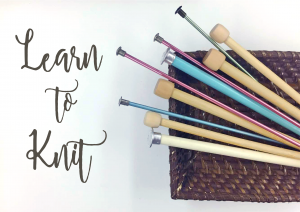
Learn to Knit
Last week we learned that knitting is the art of creating a fabric by making interlocking loops of yarn. There are two basic ways to create these loops: The action of inserting your needles through the bottom of a loop and pulling a new loop down and through the first loop is called ‘knitting’.
The action of inserting your needles from the top of a loop and pulling a new loop up and through the first stitch is called ‘purling’. You can insert the working needle (the needle held in the right hand) into the working stitch (the one on the left needle) either in on top (in front) or underneath (in back) of the left needle. When you insert the working needle underneath, this is called ‘working through the back loop’. When you insert the working needle on top, this is called ‘working through the front loop’. Combining knit or purled stitches and changing whether the stitch is worked through the back or front loop gives a knitted fabric its texture and pattern. There are different methods for holding the yarn and needles. In the ‘English’ method, the yarn is controlled and looped (or ‘thrown’) with the right hand to create stitches. In the ‘Continental’ method, the yarn is controlled in the left hand and the stitches are made by ‘picking’ loops off the left needle with the needle held in the right hand. Some knitters feel that the Continental method is faster because there is less waste motion. Because the yarn is controlled in the left hand, the Continental method may also be a little easier for left-handed knitters and somewhat more difficult for right-handed ones. Both methods work well and if one does not feel comfortable to you, you may want to try the other one. This tutorial teaches you how to purl through the front loop using the English method.
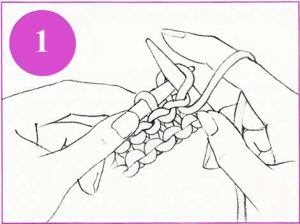
Step 1: To make a purl stitch, you do all the same steps as you do to make a knit stitch except with slightly different motions. Hold the needles as if to knit — the needle with the stitches is in your left hand and the empty needle is in your right hand. . Place the yarn from the existing piece and the ball IN FRONT of the left needle. Insert the right needle towards you through the first stitch on the left needle (right to left, from the back to the front). The right needle will be on top of the left needle and pointing towards you (downward.)
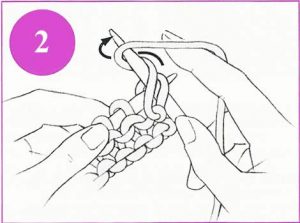
Step 2: Loop the yarn from the left needle around the tip of the right needle from the front around the back in a downward counter-clockwise motion (the motion that is opposite the direction that the hands of the clock move)
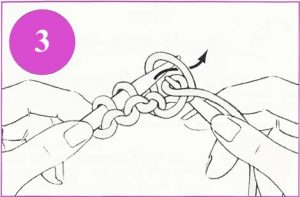
Step 3: To make sure you don’t lose the loop, place your right thumb over the yarn on the right needle so it won’t come loose when you move the needle. Slide the tip of the right needle and the yarn on it through the center of the stitch on the left needle, moving it away from you.
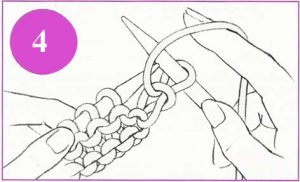
Step 4: With the tip of the right needle, pull the new loop off the tip of the left needle. You now have a stitch on your right needle.
You have just made your first purl stitch!
Repeat steps 1 through 4 to complete the row. If the process feels a little awkward, you are not alone. If you have only done the knit stitch, it will seem a little strange, but soon you’ll feel at home using both stitches.
When you have finished this row, turn your work (place the full needle in your left hand and the empty needle in your right hand) and KNIT the next row. After that, PURL the next row. Continue working, alternating each knit row with a purl row.
The process of alternating knit and purl rows creates stockinette stitch. Stockinette is smooth on one side with stitches that look and feel like V’s. That’s the knit side. The other side of a piece that is knitted in stockinette stitch looks and feels like it is covered with bumps. and ridges. When you are knitting stockinette, the side that is smooth is considered to be the right side (abbreviated ‘RS’). The purl side with the bumps and ridges is considered to be the wrong side (abbreviated ‘WS’).
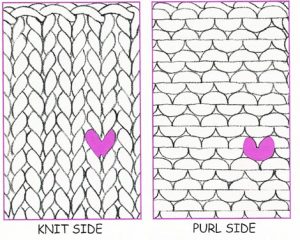
When you are holding the work on the needles in your left hand if the smooth side with the V’s is facing you, you are on the knit side and should knit the row. If the bumps are facing you, you are on the purl side, so purl the row.
Check out the video tutorial here!
You now know the two stitches that make everything possible in the knitting world!